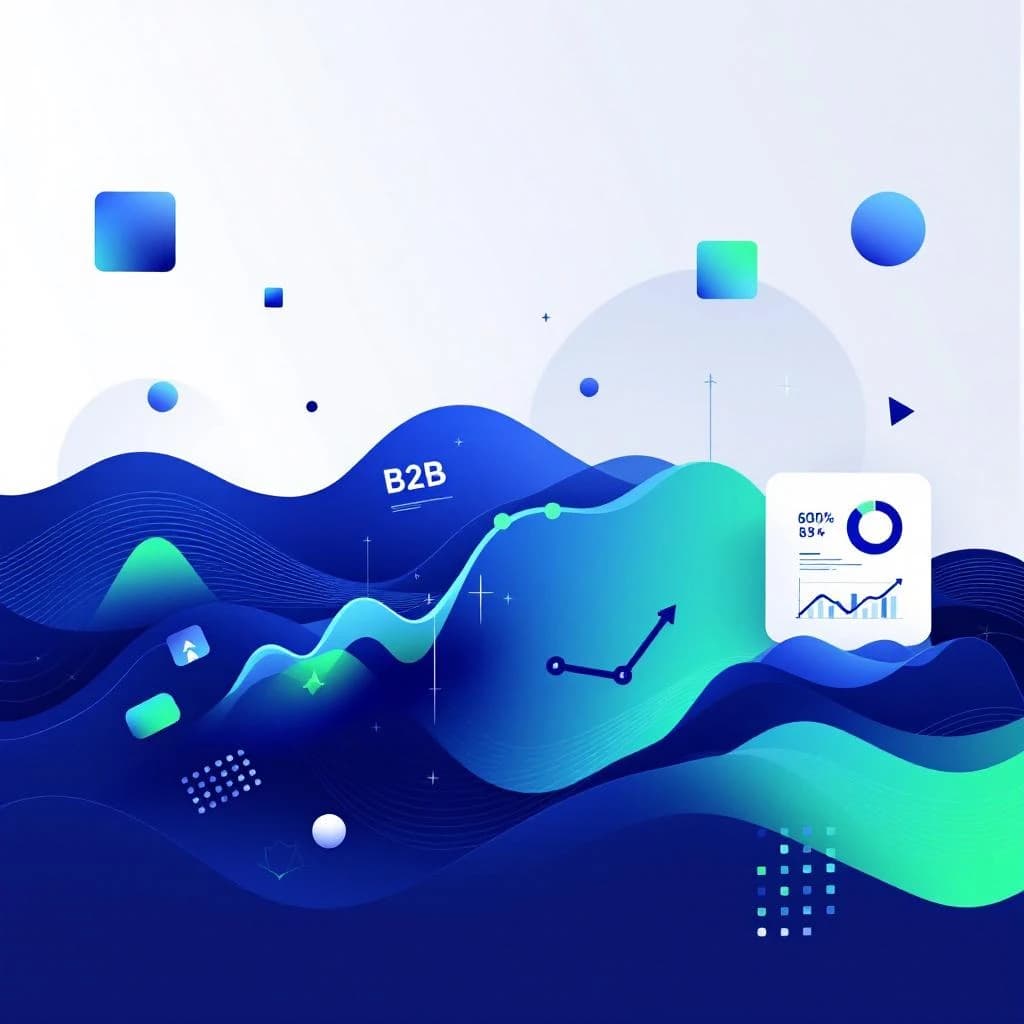What is Sales Prospecting? Complete B2B Guide (2024)

What is Sales Prospecting? Complete B2B Guide (2024)
Every B2B sales leader faces the same brutal reality: 82% of B2B buyers feel sales reps are unprepared when they engage with prospects. This staggering statistic reveals a fundamental breakdown in how companies approach sales prospecting.
In today's competitive B2B landscape, traditional spray-and-pray tactics no longer work. Buyers are more informed, more selective, and have higher expectations than ever before. The companies that thrive are those that master the art and science of strategic sales prospecting.
This comprehensive guide will transform how you think about prospecting. You'll discover proven frameworks, data-driven strategies, and actionable techniques that top-performing B2B teams use to build predictable pipeline and scale their outreach with precision.
Understanding Sales Prospecting in the B2B Context
Sales prospecting is the systematic process of identifying, researching, and engaging potential customers who fit your ideal customer profile (ICP). It's the foundation of any successful B2B sales strategy, serving as the bridge between marketing efforts and closed deals.
Unlike B2C sales, B2B prospecting involves complex decision-making units, longer sales cycles, and higher-value transactions. This complexity demands a more sophisticated approach that combines strategic thinking with tactical execution.
📊 Key Stat: Companies that excel at prospecting generate 50% more sales-ready leads at 33% lower cost per lead.
Effective B2B prospecting goes beyond simply collecting contact information. It requires deep understanding of your prospects' business challenges, decision-making processes, and buying triggers. This intelligence enables you to craft personalised outreach that resonates with their specific needs and circumstances.
The Modern Prospecting Landscape
The B2B buying process has fundamentally shifted. Today's buyers conduct extensive research before engaging with sales teams, often completing 57% of their buying journey independently. This means your prospecting efforts must provide genuine value from the very first touchpoint.
Successful prospecting teams focus on becoming trusted advisors rather than persistent vendors. They use data and insights to identify prospects at the right moment in their buying journey, then deliver relevant, helpful content that advances the conversation.
The Strategic Framework for B2B Sales Prospecting
1. Ideal Customer Profile (ICP) Development
Your ICP is the foundation of effective prospecting. It's a detailed description of the companies and decision-makers who are most likely to buy your solution and achieve success with it.
Developing a robust ICP involves analysing your best customers across multiple dimensions:
- Firmographics: Company size, industry, revenue, growth stage
- Technographics: Current technology stack, digital maturity
- Behavioural indicators: Buying patterns, decision-making processes
- Pain points: Specific challenges your solution addresses
💡 Pro Tip: Review your ICP quarterly. As your product evolves and market conditions change, your ideal customer profile should adapt accordingly.
2. Multi-Channel Prospecting Strategy
Modern B2B prospecting requires a coordinated approach across multiple channels. No single channel delivers optimal results in isolation. The most effective strategies combine:
Email Prospecting: Still the backbone of B2B outreach, but requires sophisticated personalisation and value-driven messaging.
LinkedIn Outreach: Essential for building relationships and establishing credibility with key decision-makers.
Phone Prospecting: Valuable for breaking through digital noise and having real-time conversations.
Content-Based Prospecting: Using valuable content to attract and engage prospects throughout their buying journey.
3. Research and Intelligence Gathering
Successful prospecting begins with thorough research. Before reaching out to any prospect, invest time in understanding:
- Recent company news, funding rounds, or leadership changes
- Industry trends affecting their business
- Competitive landscape and positioning
- Existing technology investments
- Key stakeholders and their backgrounds
⚡ Research Framework: Spend 10-15 minutes researching each high-value prospect. This investment typically increases response rates by 30-40%.
Building Your Prospecting Process
Lead Generation and Qualification
Not all leads are created equal. Effective prospecting requires a systematic approach to lead generation and qualification that focuses your efforts on the highest-probability opportunities.
Lead Scoring Framework:
| Criteria | High Score (3) | Medium Score (2) | Low Score (1) |
|---|---|---|---|
| Company Size | Perfect ICP fit | Close to ICP | Outside ICP |
| Budget Authority | Confirmed budget | Likely budget | Unknown budget |
| Timeline | Immediate need | 3-6 months | 6+ months |
| Pain Level | Critical pain | Moderate pain | Low pain |
This scoring system helps prioritise your outreach efforts and allocate resources to prospects with the highest conversion potential.
Personalisation at Scale
Personalisation is non-negotiable in modern B2B prospecting. However, truly personalised outreach at scale requires systematic approaches and smart use of technology.
Three Levels of Personalisation:
- Basic: Using prospect's name, company, and role
- Intermediate: Referencing recent company news or industry trends
- Advanced: Connecting specific business challenges to your solution's capabilities
📊 Impact Data: Personalised prospecting messages generate 18% higher reply rates compared to generic outreach.
The key is developing templates and frameworks that allow for meaningful personalisation without requiring extensive time investment for each prospect.
Prospecting Channels and Tactics
Email Prospecting Excellence
Email remains the most scalable prospecting channel, but success requires sophisticated execution. The days of generic blast emails are long gone.
High-Converting Email Structure:
- Subject Line: Specific, relevant, and curiosity-driven
- Opening: Personal connection or relevant insight
- Value Proposition: Clear benefit tied to their business
- Social Proof: Brief credibility indicator
- Call-to-Action: Specific, low-commitment next step
Email Sequence Strategy:
- Email 1: Introduction and value proposition
- Email 2: Case study or social proof (3-4 days later)
- Email 3: Different angle or additional insight (1 week later)
- Email 4: Final attempt with breakup message (1 week later)
LinkedIn Prospecting Mastery
LinkedIn has become an essential prospecting channel for B2B sales teams. The platform's professional context makes it ideal for building relationships and establishing credibility.
LinkedIn Prospecting Sequence:
- Profile optimisation: Ensure your profile positions you as a trusted advisor
- Connection request: Personalised message explaining mutual value
- Value-first message: Share relevant insight or resource
- Relationship building: Engage with their content and build rapport
- Meeting request: Suggest specific value-driven conversation
💡 LinkedIn Insight: Sales professionals who actively use LinkedIn are 51% more likely to reach quota than those who don't.
Phone Prospecting in the Digital Age
While digital channels dominate modern prospecting, phone outreach remains valuable for breaking through noise and having real-time conversations with prospects.
Effective Cold Calling Framework:
- Research: Know their business and recent developments
- Permission: Ask for 30 seconds to explain why you're calling
- Value: Share specific insight relevant to their business
- Discovery: Ask thoughtful questions about their challenges
- Next Steps: Suggest specific follow-up action
The key to successful phone prospecting is treating it as a conversation starter rather than a sales pitch. Your goal should be to earn the right to continue the dialogue.
Technology and Tools for Modern Prospecting
Technology has revolutionised B2B prospecting, enabling sales teams to work more efficiently and effectively than ever before. However, success depends on choosing the right tools and using them strategically.
Essential Prospecting Technology Stack
CRM Platform: Centralised database for managing prospects, tracking interactions, and measuring results. Essential for maintaining consistent follow-up and team coordination.
Sales Engagement Platforms: Tools that automate and optimise multi-channel outreach sequences while maintaining personalisation at scale.
Data and Intelligence Tools: Platforms that provide accurate contact information, company insights, and buying signals to inform your prospecting strategy.
Communication Tools: Email tracking, LinkedIn automation, and phone systems that integrate with your broader sales stack.
📊 Automation Impact: Sales teams using automation tools see 14.5% increase in sales productivity and 12.2% reduction in marketing overhead.
Leveraging AI and Machine Learning
Artificial intelligence is transforming prospecting by enabling more sophisticated lead scoring, predictive analytics, and personalisation capabilities.
AI Applications in Prospecting:
- Lead Scoring: Machine learning algorithms that identify high-probability prospects
- Content Personalisation: AI-driven message customisation based on prospect data
- Timing Optimisation: Predictive analytics for optimal outreach timing
- Conversation Intelligence: Analysis of successful prospecting interactions to improve future outreach
The key is using AI to enhance human capabilities rather than replace human judgment and relationship-building skills.
Measuring and Optimising Prospecting Performance
Successful prospecting requires continuous measurement and optimisation. Without clear metrics and regular analysis, you can't identify what's working and what needs improvement.
Key Prospecting Metrics
Activity Metrics:
- Emails sent per day
- Calls made per day
- LinkedIn connections per week
- Research time per prospect
Engagement Metrics:
- Email open rates
- Email reply rates
- LinkedIn acceptance rates
- Call connection rates
Conversion Metrics:
- Prospects to qualified leads
- Qualified leads to meetings
- Meetings to opportunities
- Opportunities to closed deals
💡 Benchmark Insight: Top-performing B2B sales teams achieve average email reply rates of 15-25% compared to industry average of 8-12%.
Continuous Improvement Process
Weekly Reviews:
- Analyse individual and team performance metrics
- Identify successful messages and tactics
- Review and update prospect research
- Plan upcoming week's activities
Monthly Optimisation:
- A/B test email templates and subject lines
- Refine ICP based on conversion data
- Update messaging based on market feedback
- Evaluate and adjust channel mix
Quarterly Strategy Reviews:
- Assess overall prospecting ROI
- Evaluate technology stack effectiveness
- Update processes based on market changes
- Set goals and priorities for next quarter
Common Prospecting Challenges and Solutions
Challenge 1: Low Response Rates
Root Causes:
- Generic, non-personalised messaging
- Poor timing of outreach
- Weak value propositions
- Targeting wrong prospects
Solutions:
- Increase personalisation depth and relevance
- Use data to optimise outreach timing
- Develop stronger, benefit-focused messaging
- Refine ICP and lead qualification criteria
Challenge 2: Difficulty Reaching Decision Makers
Root Causes:
- Targeting wrong contacts within organisations
- Insufficient research on organisational structure
- Weak referral and introduction strategies
Solutions:
- Map decision-making units more thoroughly
- Develop multi-threading strategies
- Build relationships with influencers and champions
- Use warm introductions whenever possible
Challenge 3: Scaling Personalised Outreach
Root Causes:
- Over-reliance on manual processes
- Lack of systematic personalisation frameworks
- Insufficient use of automation tools
Solutions:
- Implement sales engagement platforms
- Develop personalisation templates and frameworks
- Use AI-powered personalisation tools
- Create efficient research processes
⚡ Pro Tip: Focus on solving one challenge at a time. Trying to fix everything simultaneously often leads to inconsistent execution and poor results.
Advanced Prospecting Strategies
Account-Based Prospecting
For high-value enterprise accounts, traditional prospecting approaches often fall short. Account-based prospecting focuses intensive, coordinated efforts on specific target accounts.
Account-Based Prospecting Process:
- Account Selection: Choose 10-20 high-value target accounts
- Stakeholder Mapping: Identify all relevant decision-makers and influencers
- Research and Intelligence: Deep dive into account challenges and priorities
- Coordinated Outreach: Multi-person, multi-channel engagement strategy
- Value Creation: Develop account-specific insights and solutions
Social Selling Integration
Social selling has become an essential component of modern prospecting. It's about building relationships and establishing credibility through social platforms.
Social Selling Best Practices:
- Share valuable, relevant content consistently
- Engage authentically with prospects' content
- Position yourself as a thought leader in your space
- Use social insights to inform prospecting strategy
- Build relationships before making sales pitches
📊 Social Selling Impact: Sales professionals who excel at social selling create 45% more opportunities than peers with lower social selling scores.
Building a High-Performance Prospecting Team
Hiring and Training
Building an effective prospecting team requires careful attention to hiring, training, and ongoing development.
Key Prospecting Skills:
- Research and analytical abilities
- Written and verbal communication excellence
- Persistence and resilience
- Technology proficiency
- Strategic thinking capabilities
Training Framework:
- Product and Market Knowledge: Deep understanding of solutions and target markets
- Prospecting Methodology: Systematic approach to research, outreach, and follow-up
- Tool Proficiency: Effective use of CRM, engagement platforms, and research tools
- Communication Skills: Email writing, phone skills, and social selling
- Continuous Learning: Regular skill updates and best practice sharing
Team Structure and Specialisation
As teams grow, specialisation often improves efficiency and results.
Prospecting Team Roles:
- Research Specialists: Focus on lead qualification and prospect intelligence
- Outreach Specialists: Execute multi-channel prospecting sequences
- Channel Specialists: Deep expertise in specific prospecting channels
- Account Development Reps: Focus on inbound lead follow-up and nurturing
Key Takeaways
- Sales prospecting is the systematic process of identifying and engaging potential B2B customers who match your ideal customer profile
- Modern prospecting requires a multi-channel approach combining email, LinkedIn, phone, and content-based strategies
- Personalisation at scale is essential, with personalised messages generating significantly higher response rates than generic outreach
- Technology and AI are transforming prospecting by enabling better lead scoring, timing optimisation, and automated personalisation
- Continuous measurement and optimisation of key metrics like reply rates, conversion rates, and pipeline generation are critical for success
- Account-based prospecting and social selling have become essential strategies for reaching high-value enterprise prospects
- Building a high-performance prospecting team requires systematic hiring, training, and ongoing skill development
Conclusion
Sales prospecting has evolved from a numbers game to a strategic discipline that combines data-driven insights with personalised human engagement. The companies that master this evolution will build predictable pipeline and achieve sustainable growth in today's competitive B2B landscape.
Success in modern prospecting requires the right combination of strategy, process, technology, and skills. It demands continuous learning, adaptation, and optimisation based on market feedback and performance data.
If you're looking to build predictable pipeline and scale your GTM execution, ProspectX can help. We deliver elite execution through data-driven strategies that book qualified meetings and drive consistent revenue growth. Our systematic approach to what is sales prospecting has helped dozens of B2B companies transform their prospecting results and achieve their growth objectives.
Ready to Build Predictable Pipeline?
ProspectX delivers elite GTM execution through data-driven strategies. We handle everything from ICP research to qualified meetings in your target markets—helping you scale with precision.


